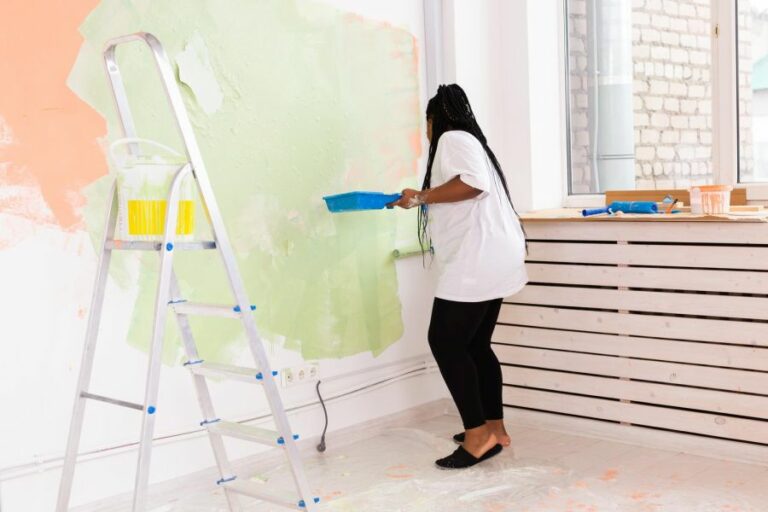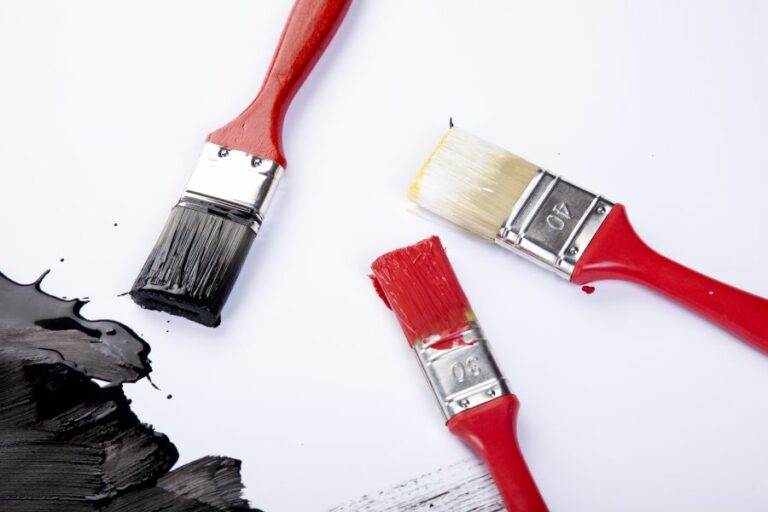Outdoor Chair Paint, 25 Things You Should Know
Are you looking to spruce up your outdoor space with a fresh coat of paint on your outdoor chairs? Over time, the elements can take a toll on your outdoor furniture, and a new paint job can make all the difference. Luckily, we’ve got all the tips and tricks you’ll need to transform your outdoor seating and help them look as good as new.
Outdoor chair paint:
To paint outdoor chairs, choose a suitable paint type such as latex, oil-based, enamel, or specialty paints. Properly prepare the chairs by cleaning, sanding, priming, and masking. Use the right tools, apply thin coats, follow proper technique, and seal with a protective finish for durability and a fresh look.

Dive into the world of outdoor chair paint as we explore color options, choosing the right paint type, and provide step-by-step painting tips. Keep reading for creative ideas on how to give your outdoor chairs a fresh, inviting look and increase their lifespan. Don’t miss out!
Contents
- 1 Exterior Chair Paint Solution
- 2 Which Type of Paint is Suitable for Patio Chairs?
- 3 What Type of Paint Should Be Utilized for Outdoor Furniture?
- 4 What Type of Paint is Suitable for Outdoor Wooden Chairs?
- 5 Is it Possible to Apply Paint on Outdoor Fabric Chairs?
Exterior Chair Paint Solution
Outdoor chairs endure various weather conditions, making their maintenance crucial.
• Types of Paint for Outdoor Chairs
There are several types of paint suitable for outdoor furniture, each with its unique benefits and drawbacks. The most common types include:
– Latex paints
Latex paints are water-based and highly versatile, making them suitable for various surfaces, including metal, wood, and plastic. They’re also resistant to water damage and fading, and can be cleaned easily with soap and water.
However, they may not be as tough as other paint types, thus requiring frequent touch-ups.
– Oil-based paints
Oil-based paints are highly durable, which makes them perfect for surfaces exposed to harsh weather conditions. They also offer excellent adhesion and can fill minor surface imperfections. However, they may take longer to dry, have a strong odor, and require solvents to clean brushes and spills.
– Enamel paints
Enamel paints provide a hard and glossy finish, making them ideal for protecting your outdoor chairs from wear and tear. They are also rust and corrosion-resistant, which is essential when dealing with metal furniture.
The main drawback with enamel paints is that they are high in Volatile Organic Compounds (VOCs), which can lead to health and environmental concerns.
– Specialty paints
Specialty paints, like Rust-Oleum’s line of outdoor furniture paint, offer unique features for specific applications. For instance, some are specifically designed for plastic furniture, while others are made for high-traffic areas. These can be useful for targeting particular issues with your outdoor chairs.
• Preparing Your Outdoor Chairs for Painting
Before painting your outdoor chairs, you must prepare them correctly to achieve the best results. Here are the essential steps in the preparation process:
– Cleaning
Remove any dirt, debris, or mildew on your chairs by using a soft brush, mild soap, and water. Rinse them thoroughly and allow them to dry completely before moving on to the next step.
– Sanding
Sanding is crucial for removing loose or peeling paint and creating a smooth surface for the new paint to adhere to. Use sandpaper with 80-150 grit for wooden chairs and 180-220 grit for metal or plastic chairs. After sanding, wipe down your chairs with a tack cloth or damp rag to remove dust.
– Priming
Applying a primer is vital to ensure proper adhesion, improve the durability of the paint, and prevent rust or stain bleed-through. Choose a primer specifically designed for the material of your outdoor chairs.
– Masking
Cover any areas you don’t want to paint, like hardware or cushions, using painter’s tape and plastic sheeting or drop cloths.
• Painting Tips for Outdoor Chairs
After your chairs are adequately prepared, it’s time to choose the right paint and apply it correctly. Follow these tips to ensure a flawless finish:
– Test a small area
Before fully committing to paint color, apply a small amount to an inconspicuous area of your outdoor chair to ensure you’re happy with the color and finish.
– Use the right tools
Choose high-quality brushes, rollers, or paint sprayers suitable for your chosen paint type. Make sure you have a variety of brush sizes and shapes to reach tight corners and crevices.
– Apply thin coats
Applying thin coats of paint is better than heavy ones, which can result in streaks or drips. Allow each coat to dry fully, as per the manufacturer’s recommendations, before applying the next one.
– Use proper technique
Whether you’re using a brush, roller, or paint sprayer, ensure you’re following best practices for that specific tool. This will help you achieve a smooth, even finish with minimal brushstrokes or overspray.
– Seal and protect
Once your paint is fully dry, consider applying a clear protective finish or sealant to help protect your outdoor chairs from the elements and prolong the life of the paint.
• In Conclusion
Properly painting and maintaining outdoor chairs can significantly improve their appearance and durability. By using the appropriate paint, preparing the chairs correctly, and following the tips given in this article, you can ensure your outdoor chairs remain fresh and inviting for years to come.
Which Type of Paint is Suitable for Patio Chairs?
Revamping your patio furniture can give your outdoor space an entirely new look and feel. One simple and cost-effective way of bringing new life to your patio chairs is by applying a fresh coat of paint. But with so many different types and brands on the market, choosing the right paint can be a daunting task.
• Types of Paint Suitable for Patio Chairs
– Outdoor Acrylic Paint
Outdoor acrylic paints are water-based paints that work well on various surfaces, from wood and metal to plastic and fabric. Acrylic paints are known for their versatility, quick drying time, and low odor. Plus, they are easy to clean up with just soap and water.
Acrylic paint is resistant to weathering and fading, making it a popular choice for outdoor projects like patio chairs. However, when using outdoor acrylic paint on wood, make sure the wood is sealed properly prior to painting, as water can cause the wood to rot or warp.
Examples of good quality outdoor acrylic paints are DecoArt Patio Paint and FolkArt Outdoor Paint.
– Oil-Based Paint
Oil-based paint is another option for patio chairs, particularly for metal surfaces. This type of paint offers excellent adhesion, durability, and protection from rust and other elements.
However, oil-based paint takes longer to dry than acrylic paint and tends to have a strong odor. Cleanup also requires solvents like mineral spirits or paint thinner.
Examples of oil-based paint suitable for outdoor use are Rust-Oleum Protective Enamel and Sherwin-Williams All Surface Enamel.
– Spray Paint
Spray paint can be a quicker and more efficient option for painting patio chairs, as it allows for easier coverage of hard-to-reach areas and intricate designs. Both acrylic and oil-based spray paints are available for outdoor use.
Look for spray paints specifically formulated for outdoor furniture, like Rust-Oleum Painter’s Touch 2X Ultra Cover or Krylon Fusion All-In-One, which offer added protection from the elements.
• Selecting the Best Paint for Your Patio Chairs
– Material
The first factor to consider when choosing paint for your patio chairs is the material they are made from. Different paints adhere better to specific materials:
- Wood: Outdoor acrylic paint or oil-based paint are suitable choices for wooden patio chairs. Be sure to prime and seal the wood first, especially if it will be exposed to the elements.
- Metal: Oil-based paint or specially formulated spray paint for metal is recommended. Be sure to remove any rust or peeling paint before painting.
- Plastic: Use a paint specifically designed for plastics, such as outdoor acrylic paint, or a spray paint suitable for plastics like Krylon Fusion for Plastic.
– Durability
Durability is a top priority when choosing paint for patio chairs. The paint must withstand weather conditions like sun, rain, and temperature changes. Opt for outdoor-specific paints or formulations which are designed to provide resistance to fading, chipping, and weathering.
– Environmental Factors
Keep in mind the environmental impact of your paint choice, as some types of paint may contain potentially harmful chemicals. Water-based paints, like outdoor acrylics, are typically considered more environmentally friendly than oil-based paints.
– Finishing Touches
Once you’ve selected the right type of paint for your patio chairs, consider adding a clear, protective topcoat for added durability and protection from the elements.
A clear, water-based polyurethane or a specialized outdoor furniture sealer/finish can provide an extra layer of protection to your newly painted chairs.
• In Conclusion
Choosing the right paint for your patio chairs involves considering factors such as the material, durability, environmental impact, and desired finish. With proper care and attention, a fresh coat of paint can help breathe new life into your patio chairs and transform your outdoor space.
Paint Type | Description |
|---|---|
Exterior Latex Paint | Water-based paint suitable for outdoor furniture, resistant to weather conditions, and dries quickly. |
Acrylic Paint | Water-based paint with excellent adhesion and flexibility, suitable for outdoor use and resistant to fading and chipping. |
Oil-Based Paint | Durable and water-resistant paint, ideal for outdoor furniture, but has a longer drying time compared to water-based paints. |
Spray Paint | Easy to apply and gives a smooth finish, ideal for metal or plastic patio chairs, and comes in various types such as enamel or paint-primer combos. |
What Type of Paint Should Be Utilized for Outdoor Furniture?
The type of paint you use on your outdoor furniture can make a significant difference in its durability and appearance. With the right kind of paint, your furniture will not only look better, but it will also last longer.
• Types of Paint Suitable for Outdoor Furniture
There are several types of paint that can be used on outdoor furniture, each with its own set of advantages and disadvantages. We will discuss the three most common types: latex, oil-based, and specialty paints.
– Latex Paints
Latex paints are water-based, which makes them easy to clean and maintain. They dry quickly and are resistant to mold and mildew. Latex paint is an excellent choice for outdoor furniture because it provides a durable finish that can withstand exposure to the elements.
Pros
- Easy to clean with soap and water
- Quick-drying
- Resistant to mold and mildew
- Durable and long-lasting
Cons
- May not adhere as well to some surfaces, such as metal, without proper priming
- Can be more expensive than other types of paint
– Oil-Based Paints
Oil-based paints are known for their durability and ability to provide a smooth, glossy finish. They are also highly resistant to water, making them an excellent option for outdoor furniture that will be regularly exposed to moisture.
Pros
- Highly durable and resistant to water
- Provides a smooth, glossy finish
- Adheres well to a variety of surfaces
Cons
- Can take longer to dry than latex paints
- Requires mineral spirits for cleanup
- May have a strong odor
– Specialty Paints
There are a variety of specialty paints designed specifically for use on outdoor furniture. Some examples include:
- Marine paints, which are designed for boats and other watercraft but can also be used on outdoor furniture for added durability
- Rust-inhibiting paints, which are designed to prevent rust and corrosion on metal surfaces
- UV-resistant paints, provide added protection from the sun’s harmful rays
Pros
- Designed for specific purposes, providing optimal protection and durability
- Many are available in a wide range of colors and finishes
Cons
- Can be more expensive than other types of paint
- May require additional preparation and application steps
• Preparing Your Outdoor Furniture for Painting
Before you begin painting your outdoor furniture, it is essential to properly prepare the surface. This will ensure optimal adhesion and a long-lasting, durable finish. Follow these steps for proper preparation:
- Clean the furniture thoroughly to remove any dirt, dust, or debris. If necessary, use soap and water or a mild detergent.
- If the furniture has any existing paint or finish, it may need to be stripped or sanded down to provide a smooth surface for painting.
- If the furniture is made of metal, it may require priming with a rust-inhibiting primer to prevent corrosion.
- Allow the furniture to dry completely before moving on to the painting process.
• Applying Paint to Your Outdoor Furniture
The method you use to apply paint to your outdoor furniture will depend on the type of paint you have chosen. Here are some general guidelines for each type of paint:
– Latex Paints
To apply latex paint, you can use a brush, roller, or paint sprayer. Be sure to apply in thin, even coats, allowing each coat to dry completely before applying the next. Two to three coats are typically recommended for maximum durability and protection.
– Oil-Based Paints
Oil-based paints are best applied with a brush, as they can be difficult to clean from rollers or sprayers.
As with latex paint, apply in thin, even coats, and allow each coat to dry before applying the next. It is essential to note that oil-based paints take longer to dry than latex paints, so make sure to factor this into your project timeline.
– Specialty Paints
The application method for specialty paints will vary depending on the paint you have chosen. Refer to the manufacturer’s instructions for specific application guidelines.
Regardless of the type of paint you choose, it is essential to follow appropriate safety measures, such as wearing gloves, protective eyewear, and a mask, to protect yourself from potentially harmful fumes or chemicals.
• Conclusion
Painting your outdoor furniture can provide a fresh, updated look while also protecting your investment for years to come. Choosing the right paint for your furniture, properly preparing the surface, and correctly applying the paint are all crucial steps in achieving a durable, long-lasting finish.
With a bit of time and effort, your outdoor furniture can look as good as new and be ready to withstand the elements. For additional information on paint types and proper application, visit the U.S. Environmental Protection Agency website.
Paint Type | Description | Uses |
|---|---|---|
Exterior Latex Paint | Water-based paint with great durability and weather resistance. | Wood, metal, and plastic furniture. |
Oil-Based Paint | Highly durable and long-lasting paint, but with a longer drying time. | Wood and metal furniture. |
Spray Paint | Easy to apply, fast-drying paint that comes in various finishes. | Wood, metal, and plastic furniture. |
Acrylic Paint | Water-based paint with fast drying time and good weather resistance. | Wood, metal, and plastic furniture. |
Chalk Paint | Matte finish paint that gives a vintage, distressed look. | Wood furniture. |
What Type of Paint is Suitable for Outdoor Wooden Chairs?
Outdoor wooden chairs often require a fresh coat of paint to protect them from the elements and keep them looking their best. Selecting the right type of paint for your outdoor wooden chairs ensures longevity and enhances their appearance.
• Types of Paint for Outdoor Wooden Chairs
– Latex Paint
Latex paint, also known as acrylic or water-based paint, dries quickly and offers easy cleanup with soap and water. It is a popular option for outdoor wooden chairs because it provides a smooth finish and resists cracks and peeling.
Latex paint also offers excellent UV protection, keeping your chairs looking vibrant and new over time.
Recommendation: For outdoor wooden chairs, high-quality, 100% acrylic latex paint is recommended. These paints provide superior performance in terms of durability, weather resistance, and color retention.
– Oil-Based Paint
Oil-based paints have been the traditional choice for outdoor wooden chairs. These paints offer a durable and long-lasting finish that stands up against weather and wear.
Typically, oil-based paints take longer to dry compared to latex paint and thus are more challenging to work with. In addition, these paints also require mineral spirits or paint thinner for cleanup.
Due to environmental concerns and VOC (Volatile Organic Compounds) regulations, oil-based paints are becoming less popular for outdoor furniture.
However, oil-based paints still have their merits, such as creating a hard, resistant finish that can withstand harsh conditions and heavy use.
Recommendation: Only consider oil-based paint if you’re looking for a very specific finish, have experience working with this type of paint, and are prepared to follow appropriate ventilation and safety measures.
– Exterior Wood Stains
Exterior wood stains provide an alternative to traditional paint and can offer a more natural or rustic look to your outdoor wooden chairs. Stains enhance the natural grain and texture of the wood while adding color and protection against the elements.
Wood stains come in a variety of colors and opacity levels, from transparent to solid, allowing you to customize the look of your outdoor furniture.
Recommendation: Exterior wood stains are a great option if you appreciate a natural look and want to preserve the wood’s character while offering protection from the elements.
• Preparation and Application Tips
– Surface Preparation
Proper surface preparation is key to a successful paint job, and this is true for any painting project, including outdoor wooden chairs.
- Clean the chair’s surface thoroughly, removing any dirt, mildew, or debris with a stiff brush and a cleanser specifically designed for wooden surfaces.
- Allow the chair to dry completely before proceeding.
- Inspect the chair for any loose or peeling paint, and remove it using a paint scraper and sandpaper.
- Sand the entire surface lightly with medium-grit sandpaper, paying special attention to any rough or uneven spots.
- Wipe down the chair with a tack cloth to remove any dust or debris from sanding.
– Primer
Applying a primer is an essential step in ensuring the longevity of the paint job on your outdoor wooden chairs. Primers help the paint adhere better and promote a smoother, more consistent finish, improving the overall appearance and durability of the paint.
Recommendation: Choose a high-quality exterior wood primer that is compatible with the type of paint you’ve selected. An acrylic primer is suitable for latex paints, while an oil-based primer should be used with oil-based paints.
– Painting
Once your surface is prepped and your primer is applied, you’re ready to paint your outdoor wooden chairs.
- Apply the paint evenly using a high-quality brush, working in long, consistent strokes.
- Be sure to cover all surfaces of the chair, including any nooks and crannies.
- Allow the paint to dry completely before applying a second coat, following the manufacturer’s recommended drying time.
- If needed, apply additional coats until the desired coverage and finish are achieved.
– Protective Coatings
To enhance the durability and longevity of your painted wooden chairs, consider applying a protective clear coat, such as polyurethane or spar urethane. These coatings offer an extra layer of protection against weather, UV rays, and wear, ensuring that your chairs continue to look great for years to come.
Recommendation: Choose a clear coat product compatible with your selected paint type and follow the manufacturer’s instructions for application.
• Conclusion
In summary, the best type of paint for outdoor wooden chairs depends on your preferences, the desired appearance, and the level of durability needed. High-quality, 100% acrylic latex paint offers a great balance of performance, ease of use, and environmental considerations.
However, oil-based paints and wood stains may be suitable alternatives in some cases.
By following appropriate preparation and application methods and adding appropriate protective coatings, you can achieve a beautiful, long-lasting finish on your outdoor wooden chairs.
Type of Paint | Description |
|---|---|
Latex Paint | Water-based paint that is durable and easy to clean. It dries quickly and has good resistance to weather conditions. |
Oil-Based Paint | Provides a long-lasting and durable finish but can take longer to dry. It offers good protection against moisture and weather conditions. |
Acrylic Paint | Water-based paint that is more resistant to fading and damage from the sun’s UV rays. It provides a durable and long-lasting finish. |
Exterior Wood Stain | Not technically a paint, but it can be used on outdoor wooden chairs to protect the wood and provide a semi-transparent finish that shows the natural grain. |
Marine Paint | Designed specifically for marine environments, this paint offers excellent protection against water damage, UV rays, and harsh weather conditions. |
Is it Possible to Apply Paint on Outdoor Fabric Chairs?
Outdoor fabric chairs are a popular choice for many homeowners due to their durability, comfort, and ease of maintenance. However, over time, these chairs might fade or become stained, prompting the question: Can you paint outdoor fabric chairs?
The answer is yes, and in this comprehensive guide, we will discuss the steps and tips to effectively paint outdoor fabric chairs to give them a fresh, new look.
• Choosing the Right Paint for Outdoor Fabric Chairs
When painting outdoor fabric chairs, it is critical to choose the right type of paint. Generally, acrylic fabric paint or fabric spray paint is recommended for this task. These paints are designed specifically for use on fabrics, allowing them to bond well to the material while maintaining flexibility and durability.
It is essential to choose a paint that is waterproof and UV-resistant, as these features will ensure that the paint withstands the elements and maintains its color over time. One such example is Simply Spray Outdoor Paint, which is specially designed for painting outdoor fabrics.
• Preparing the Chairs for Painting
Before painting your outdoor fabric chairs, it is important to properly clean and prepare the surface to ensure the paint adheres well and lasts longer.
– Cleaning the Chairs
Thoroughly clean the chairs by removing any dirt or debris using a brush, vacuum cleaner, or damp cloth. For stubborn stains, it may be necessary to use a mild detergent or fabric cleaner. Once the chairs are clean, let them dry completely before moving on to the next step.
– Sanding the Chairs (Optional)
Some outdoor fabric chairs might have a protective coating that can interfere with paint adhesion. In such cases, lightly sanding the surface using fine-grit sandpaper (220-grit or higher) can help remove this layer and provide a better surface for the paint to bond.
– Applying a Primer (Optional)
Applying a fabric primer can help improve paint adhesion, enhance color vibrancy, and provide additional protection to the chairs. There are fabric primers specifically designed for this purpose, like Rust-Oleum Fabric & Vinyl Primer.
To apply the primer, follow the manufacturer’s instructions on the product’s label. Allow the primer to dry completely before moving on to the painting process.
• Painting Outdoor Fabric Chairs
Now that the chairs are prepared, it’s time to paint them.
– Using Acrylic Fabric Paint
- Setup: Start by laying down a drop cloth or plastic sheet to protect the surrounding area. Place the chair on the cloth and make sure it is completely dry.
- Applying the Paint: Using a brush or sponge, apply the acrylic fabric paint evenly across the surface of the chair. Use even strokes and work in small sections to ensure consistent coverage.
- Drying Time: Allow the paint to dry according to the manufacturer’s instructions, which can typically range from 2-24 hours. You may need to apply additional coats depending on the desired color intensity and coverage.
- Sealing the Paint: Once the paint has dried, it’s recommended to apply a fabric sealer to protect the painted surface and make it more resistant to water and UV damage. Some fabric paints include a built-in sealer, but if not, there are various fabric sealers available on the market.
– Using Fabric Spray Paint
- Setup: Lay down a drop cloth or plastic sheet to protect the surrounding area. Place the chair on the cloth and make sure it is completely dry.
- Applying the Paint: Shake the fabric spray paint can well and hold it approximately 6-8 inches from the chair’s surface. Apply the paint using even, sweeping motions, overlapping each stroke slightly to ensure consistent coverage.
- Drying Time: Allow the paint to dry according to the manufacturer’s instructions, typically around 1-2 hours. Additional coats may be necessary for the desired color and coverage.
- Sealing the Paint: Apply a fabric sealer, as described above, to protect the painted surface and increase its durability.
• Tips for a Successful Outdoor Fabric Chair Painting Project
- Always test the paint on a small, inconspicuous area of the chair to ensure compatibility and desired results.
- Wear gloves and a mask when painting to protect your hands and lungs from paint fumes.
- When using fabric spray paint, it’s best to work in a well-ventilated area to avoid inhaling paint fumes. Always follow the manufacturer’s instructions for proper use and safety precautions.
- Adding a fabric medium to acrylic paint can improve its flexibility and reduce the risk of cracking.
• Conclusion
Yes, you can paint outdoor fabric chairs, and doing so is a relatively simple and cost-effective way to refresh their appearance. By following the steps outlined in this comprehensive guide and choosing the right paint, you can breathe new life into your outdoor chairs and enjoy them for many seasons to come.
| Can you paint outdoor fabric chairs? | |
|---|---|
| Yes | It is possible to paint outdoor fabric chairs using fabric paints, fabric spray paints, or specialized outdoor paint products. Make sure to choose the appropriate paint for the type of fabric, clean the surface before applying the paint, and follow the paint manufacturer’s instructions for best results. |







